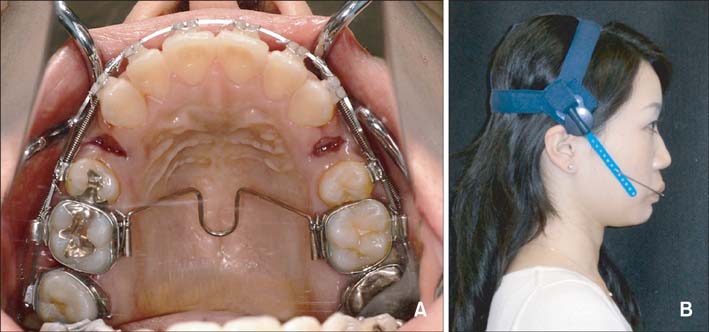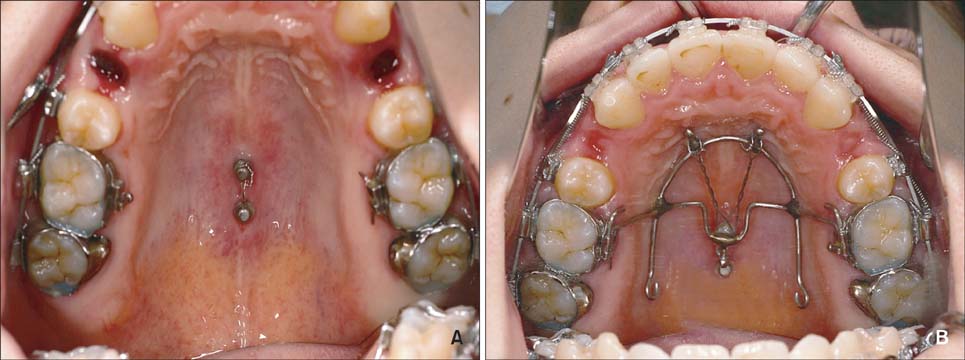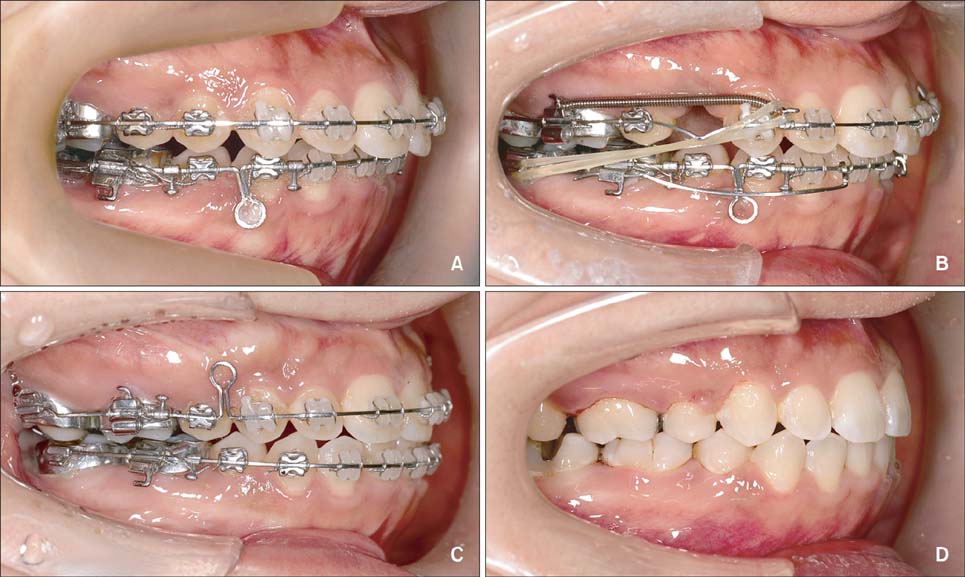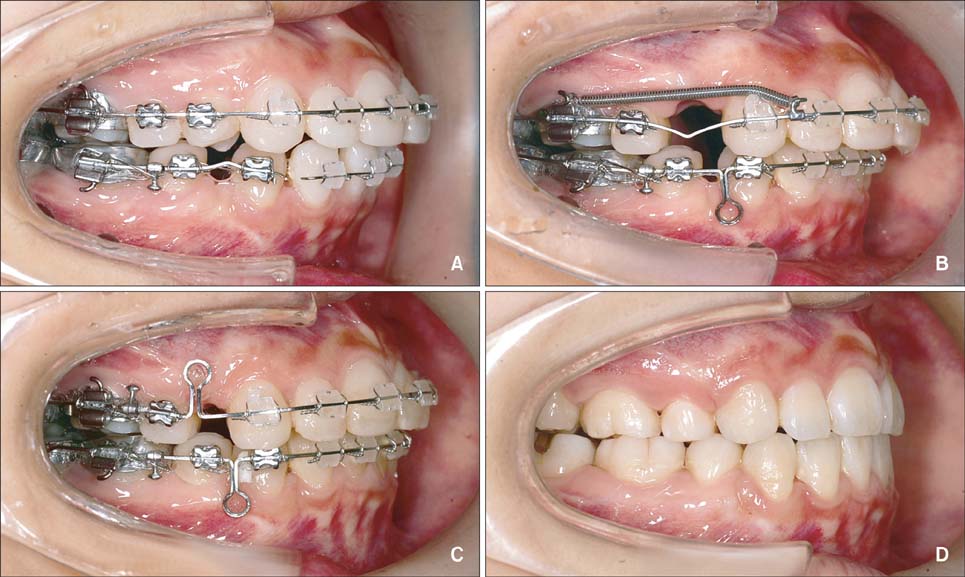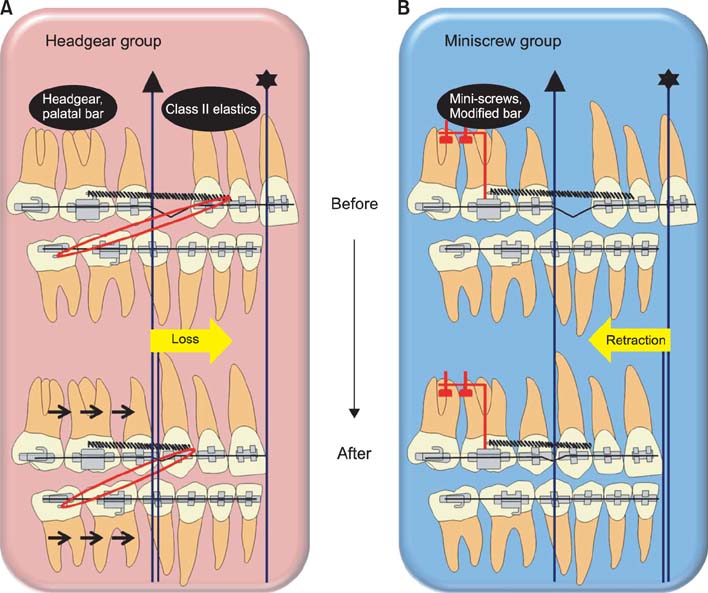Korean J Orthod.
2014 Mar;44(2):88-95. 10.4041/kjod.2014.44.2.88.
Effectiveness of en-masse retraction using midpalatal miniscrews and a modified transpalatal arch: Treatment duration and dentoskeletal changes
- Affiliations
-
- 1Department of Orthodontics, School of Dentistry, Aichi-Gakuin University, Nagoya, Japan. miyaken@dpc.aichi-gakuin.ac.jp
- KMID: 2273431
- DOI: http://doi.org/10.4041/kjod.2014.44.2.88
Abstract
OBJECTIVE
The purpose of this study was to compare the treatment duration and dentoskeletal changes between two different anchorage systems used to treat maxillary dentoalveolar protrusion and to examine the effectiveness of en-masse retraction using two miniscrews placed in the midpalatal suture.
METHODS
Fifty-seven patients (9 men, 48 women), who had undergone level anchorage system treatment at Aichi-Gakuin University Dental Hospital (Nagoya, Japan) were divided into two groups according to the method of maxillary posterior anchorage reinforcement: midpalatal miniscrews (25 patients, mean age 22 years) and conventional anchorage (32 patients, mean age 19 years). The en-masse retraction period, overall treatment duration, pre-treatment effective ANB angle, and change in the effective ANB angle were compared with an independent-samples t-test.
RESULTS
Compared to the headgear group, the duration of en-masse retraction was longer by approximately 4 months in the miniscrew group (p < 0.001). However, we found no significant difference in the total treatment duration between the groups. Moreover, a greater change in the effective ANB angle was observed in patients treated with miniscrews than in those treated with the conventional method (p < 0.05).
CONCLUSIONS
The level anchorage system treatment using miniscrews placed in the midpalatal area will allow orthodontists more time to control the anterior teeth during en-masse retraction, without increasing the total treatment duration. Furthermore, it achieves better dentoskeletal control than does the conventional anchorage method, thereby improving the quality of the treatment results.
Keyword
Figure
Cited by 2 articles
-
A three-dimensional finite element analysis of molar distalization with a palatal plate, pendulum, and headgear according to molar eruption stage
Ju-Man Kang, Jae Hyun Park, Mohamed Bayome, Moonbee Oh, Chong Ook Park, Yoon-Ah Kook, Sung-Seo Mo
Korean J Orthod. 2016;46(5):290-300. doi: 10.4041/kjod.2016.46.5.290.Analysis of midpalatal miniscrew-assisted maxillary molar distalization patterns with simultaneous use of fixed appliances: A preliminary study
Su-Jung Mah, Ji-Eun Kim, Eun Jin Ahn, Jong-Hyun Nam, Ji-Young Kim, Yoon-Goo Kang
Korean J Orthod. 2016;46(1):55-61. doi: 10.4041/kjod.2016.46.1.55.
Reference
-
1. Bills DA, Handelman CS, BeGole EA. Bimaxillary dentoalveolar protrusion: traits and orthodontic correction. Angle Orthod. 2005; 75:333–339.2. Feldmann I, Bondemark L. Orthodontic anchorage: a systematic review. Angle Orthod. 2006; 76:493–501.3. Braun S, Sjursen RC Jr, Legan HL. On the management of extraction sites. Am J Orthod Dentofacial Orthop. 1997; 112:645–655.
Article4. Park HS, Kwon TG. Sliding mechanics with microscrew implant anchorage. Angle Orthod. 2004; 74:703–710.5. Park YC, Chu JH, Choi YJ, Choi NC. Extraction space closure with vacuum-formed splints and miniscrew anchorage. J Clin Orthod. 2005; 39:76–79.6. Kyung SH. A study on the bone thickness of midpalatal suture area for miniscrew insertion. Korean J Orthod. 2004; 34:63–70.7. Kim YH, Yang SM, Kim S, Lee JY, Kim KE, Gianelly AA, et al. Midpalatal miniscrews for orthodontic anchorage: factors affecting clinical success. Am J Orthod Dentofacial Orthop. 2010; 137:66–72.
Article8. Lee JS, Kim DH, Park YC, Kyung SH, Kim TK. The efficient use of midpalatal miniscrew implants. Angle Orthod. 2004; 74:711–714.9. Chae JM. A new protocol of Tweed-Merrifield directional force technology with microimplant anchorage. Am J Orthod Dentofacial Orthop. 2006; 130:100–109.
Article10. Bae SM, Park HS, Kyung HM, Kwon OW, Sung JH. Clinical application of micro-implant anchorage. J Clin Orthod. 2002; 36:298–302.11. Thiruvenkatachari B, Pavithranand A, Rajasigamani K, Kyung HM. Comparison and measurement of the amount of anchorage loss of the molars with and without the use of implant anchorage during canine retraction. Am J Orthod Dentofacial Orthop. 2006; 129:551–554.
Article12. Beckwith FR, Ackerman RJ Jr, Cobb CM, Tira DE. An evaluation of factors affecting duration of orthodontic treatment. Am J Orthod Dentofacial Orthop. 1999; 115:439–447.
Article13. Fisher MA, Wenger RM, Hans MG. Pretreatment characteristics associated with orthodontic treatment duration. Am J Orthod Dentofacial Orthop. 2010; 137:178–186.
Article14. Skidmore KJ, Brook KJ, Thomson WM, Harding WJ. Factors influencing treatment time in orthodontic patients. Am J Orthod Dentofacial Orthop. 2006; 129:230–238.
Article15. Upadhyay M, Yadav S, Nagaraj K, Patil S. Treatment effects of mini-implants for en-masse retraction of anterior teeth in bialveolar dental protrusion patients: a randomized controlled trial. Am J Orthod Dentofacial Orthop. 2008; 134:18–29.
Article16. Yao CC, Lai EH, Chang JZ, Chen I, Chen YJ. Comparison of treatment outcomes between skeletal anchorage and extraoral anchorage in adults with maxillary dentoalveolar protrusion. Am J Orthod Dentofacial Orthop. 2008; 134:615–624.
Article17. Lee J, Miyazawa K, Tabuchi M, Kawaguchi M, Shibata M, Goto S. Midpalatal miniscrews and high-pull headgear for anteroposterior and vertical anchorage control: cephalometric comparisons of treatment changes. Am J Orthod Dentofacial Orthop. 2013; 144:238–250.
Article18. Miyazawa K, Kawaguchi M, Tabuchi M, Goto S. Accurate pre-surgical determination for self-drilling miniscrew implant placement using surgical guides and cone-beam computed tomography. Eur J Orthod. 2010; 32:735–740.
Article19. Root TL. The level anchorage system for correction of orthodontic malocclusions. Am J Orthod. 1981; 80:395–410.
Article20. Nanda RS, Kierl MJ. Prediction of cooperation in orthodontic treatment. Am J Orthod Dentofacial Orthop. 1992; 102:15–21.
Article21. Bartsch A, Witt E, Sahm G, Schneider S. Correlates of objective patient compliance with removable appliance wear. Am J Orthod Dentofacial Orthop. 1993; 104:378–386.
Article22. Slakter MJ, Albino JE, Fox RN, Lewis EA. Reliability and stability of the orthodontic Patient Cooperation Scale. Am J Orthod. 1980; 78:559–563.
Article23. Allan TK, Hodgson EW. The use of personality measurements as a determinant of patient cooperation in an orthodontic practice. Am J Orthod. 1968; 54:433–440.
Article24. Starnbach HK, Kaplan A. Profile of an excellent orthodontic patient. Angle Orthod. 1975; 45:141–145.25. Bien SM. Analysis of the components of force used to effect distal movement of teeth. Am J Orthod. 1951; 37:508–521.
Article26. Hanes RA. Bony profile changes resulting from cervical traction compared with those resulting from intermaxillary elastics. Am J Orthod. 1959; 45:353–364.
Article27. Meikle MC. The dentomaxillary complex and overjet correction in Class II, division 1 malocclusion: objectives of skeletal and alveolar remodeling. Am J Orthod. 1980; 77:184–197.
Article28. Tweed CH. The application of the principles of the edge-wise arch in the treatment of malocclusions: II. Angle Orthod. 1941; 11:12–67.29. Kocadereli I. The effect of first premolar extraction on vertical dimension. Am J Orthod Dentofacial Orthop. 1999; 116:41–45.
Article
- Full Text Links
- Actions
-
Cited
- CITED
-
- Close
- Share
- Similar articles
-
- Finite element analysis of the effects of different archwire forms and power arm positions on maxillary incisors in en masse retraction using fixed lingual orthodontic appliances
- Indirect palatal skeletal anchorage (PSA) for treatment of skeletal Class I bialveolar protrusion
- Force changes associated with differential activation of en-masse retraction and/or intrusion with clear aligners
- A comparison of en masse retraction of six anterior teeth with separate canine retraction
- A study on the bone thickness of midpalatal suture area for miniscrew insertion

